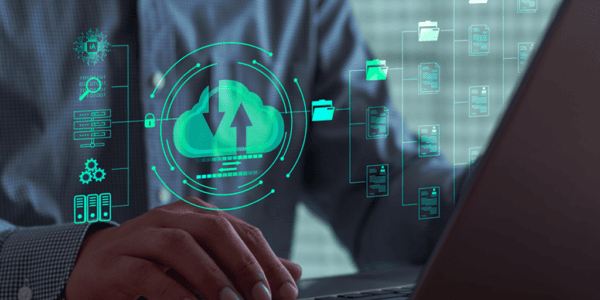
Ransomware attacks have grown into one of the most significant cybersecurity threats facing organizations. The risks extend beyond data theft, resulting in business interruptions, financial loss, and reputational damage. A robust backup strategy can significantly increase resilience to ransomware, enabling organizations to recover data quickly and minimize downtime. In this blog, we’ll cover the critical components of a ransomware-resilient backup strategy, data replication policies, top ways to minimize attacks, and the role of private cloud and modern infrastructure in strengthening ransomware defenses.
The Role of Backup Strategies in Ransomware Resilience
A solid backup strategy isn’t just about creating duplicates of your data—it’s about having the right systems and policies in place to ensure you can recover quickly and seamlessly from any data loss incident. Here are the essential components of a ransomware-resilient backup strategy:
- The 3-2-1 Backup Rule: This golden rule ensures that you always have three copies of your data stored in two different formats, with one copy kept offsite. Having backups in different locations makes it difficult for ransomware to simultaneously encrypt all your data.
- Immutable Backups: Immutable backups are write-protected, making them impossible to alter or delete once they are created. In the case of a ransomware attack, having immutable backups guarantees you’ll have untainted data to recover.
- Incremental and Differential Backups: Only backing up data that has changed since the last backup.
- Regular Backup Testing: Even the most carefully crafted backup plan is useless if it fails during recovery. Conducting regular tests ensures your backups work when you need them most.
- Automated Backup Policies: Ensuring timely backups without relying on human intervention.
Data Replication Policies for Added Protection
Data replication, especially when done in real-time or near real-time, ensures that critical data is continuously duplicated across multiple locations or environments. This prevents a single point of failure and improves recovery time in case of attacks.
Key elements of a ransomware-resistant data replication policy include:
- Geo-Redundancy: Storing copies of data in geographically dispersed locations, ensuring availability even if a region faces an attack.
- Snapshot Replication: Creating immutable snapshots of the data, which cannot be altered by ransomware.
- Replication to Air-Gapped Systems: Ensuring at least one replica remains inaccessible to the primary network, making it unreachable by ransomware.
- Synchronous Replication: Data is mirrored in real time between multiple locations. This ensures immediate failover capabilities in case of an attack, minimizing downtime.
- Asynchronous Replication: In this method, data is replicated at intervals, allowing a balance between performance and protection. It offers flexibility but ensures that ransomware won’t spread as easily across different systems.
Seven Ways to Minimize Ransomware Attacks
While a good backup strategy is essential, proactive steps can help reduce the likelihood of a ransomware attack in the first place. Here are seven best practices:
1. Regularly Patch Systems and Software: Keeping software and operating systems updated ensures vulnerabilities are minimized.
2. Implement Multi-Factor Authentication (MFA): Adding another layer of security significantly reduces the risk of unauthorized access.
3. Employee Training and Awareness: Educate employees on recognizing phishing attacks, which are the most common entry point for ransomware.
4. Use Endpoint Protection Solutions: Antivirus, anti-malware, and EDR (Endpoint Detection and Response) solutions provide continuous monitoring and detection.
5. Network Segmentation: Isolating parts of your network limits the spread of ransomware if a breach does occur.
6. Adopt Zero Trust Architecture: Only grant access to users, systems, and devices that have been authenticated and verified. This minimizes the pathways attackers can exploit.
7. Continuous Monitoring and Threat Detection: Implement robust monitoring to detect unusual activity early, helping prevent ransomware from spreading.
The Role of Private Cloud in Backup Strategies
Private cloud solutions offer enhanced security and customization for backup strategies compared to public cloud environments. Because private clouds are often used for mission-critical workloads, they can implement stricter access controls, encryption policies, and air-gapped backups to mitigate the risk of ransomware. Key advantages include:
- Data Isolation: Private clouds can be configured to maintain more stringent control over data access and movement, reducing the risk of ransomware infiltrating backups.
- Customization: You can integrate advanced security and backup policies that fit your organization’s unique needs, including implementing multi-level backups or replication strategies.
- Cost Efficiency: Modern private cloud environments have become more scalable, making advanced backup solutions like real-time replication and offsite storage more affordable for businesses of all sizes.
- Greater Control Over Infrastructure: IT teams can configure backups and replication policies precisely to their needs.
- Compliance & Data Sovereignty: Private cloud environments help meet stringent compliance standards that require the segregation of data.
- Integrated Security Features: Many private clouds come equipped with advanced security layers, such as firewalls and access control, which help defend against attacks.
Modernized Infrastructure and Applications as a Preventive Measure
One of the most effective ways to avoid ransomware attacks is by upgrading to modernized infrastructure and applications. Legacy systems often contain vulnerabilities that are difficult to patch, making them a prime target for attackers. By moving to modern solutions, organizations can take advantage of built-in security features that reduce the attack surface. Some preventive measures to consider:
- Cloud-Native Architectures: Cloud-native systems are more resilient to ransomware attacks due to their modularity. If one part of the infrastructure is compromised, it doesn’t necessarily affect the whole system.
- Resilient Storage Solutions: Using storage solutions designed with redundancy, like object storage with built-in versioning, ensures your data is always recoverable even if ransomware tries to encrypt it.
- Automation and Orchestration: Automation of security patches, backups, and incident responses ensures that systems are up-to-date and resilient to ransomware.
- Containerization and Microservices: These allow for isolating applications, limiting the impact of an attack on the entire environment.
- Zero-Trust Architecture: Implementing a zero-trust model, where every interaction is authenticated and verified, drastically reduces the risk of unauthorized access.
A Leading Backup System to Invest in or Employ
Not all backup systems are created equal. When looking for ransomware-resilient systems, prioritize solutions that offer encryption, immutability, and rapid recovery. A top option we suggest is Veeam Backup & Replication. Known for its rapid recovery features, Veeam offers automated backups, replication, and built-in ransomware protection features such as: immutable backups, instant recovery, automated backup testing, SureBackup, instant VM recovery, and granular recovery options. Veeam is one of the best for protecting physical, virtual, and cloud workloads and their robust recovery features integrate well with modernized infrastructure.
Resilience Depends on Robust Backup Strategies
Backup strategies are not just a safeguard; they are essential for ransomware resilience. By implementing a multi-layered approach—including replication policies, private cloud solutions, modern infrastructure, and advanced tools like Veeam Backup & Replication—organizations can fortify their defenses against ransomware attacks. In an age where cyberthreats continue to evolve, a proactive and robust backup strategy can mean the difference between business continuity and catastrophic loss.


